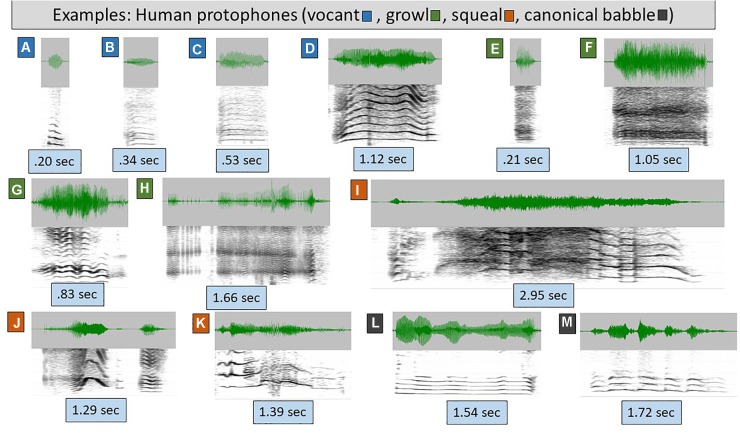FIGURE 1.
Human protophones. The spectrograms (range 4–5 kHz, 30 Hz bandwidth) and waveforms illustrate human protophones, which come in extremely variable form, as illustrated. Even these examples vastly underplay the acoustic variability of protophones. (A–D) are categorized as vocants, the most prototypical human infant vocal type, with consistent harmonic spacing and little or no dysphonation (indicating modal voice, the overwhelmingly typical human phonatory pattern in speech). The sounds were produced by 1–3 month-old typically developing human infants. Vocants are often as short as 0.1 s but can be as long as 3 s. Their intonation is not always smooth, but may involve notable variations as in D, where the rise and fall of the harmonics across time signals intonational variation. (E–H) are growls, also from 1–3 month-olds. In growls, phonation is harsh (i.e., it is chaotic, and harmonics are absent or less prominent than in vocants) as in E and F or creaky (consisting of a pulse regime, including prominent spikes in the waveform) as in G and H. As with vocants, growls can be very short or very long. (I–K) are squeals, from 0–3 month-olds. Squeals always show very high pitch (f0) as seen in widely spaced harmonics during at least a significant portion of the utterance. As with vocants and growls, squeals can be very short or very long, and as with vocants, they can involve considerable intonational variation, as seen in all three presented examples. (L,M) are reduplicated canonical babbles from 11 month-old infants. This is a vocal type that has never been documented to occur in any non-human primate even with human training. Canonical babbling involves rhythmic modulation of the acoustic waveform by movements of the jaw, lips, and/or tongue during modal phonation. From a phonatory standpoint, canonical babbles are vocants, but their supraglottal articulations result in a special pattern of well-formed syllables, adaptable for speech.

